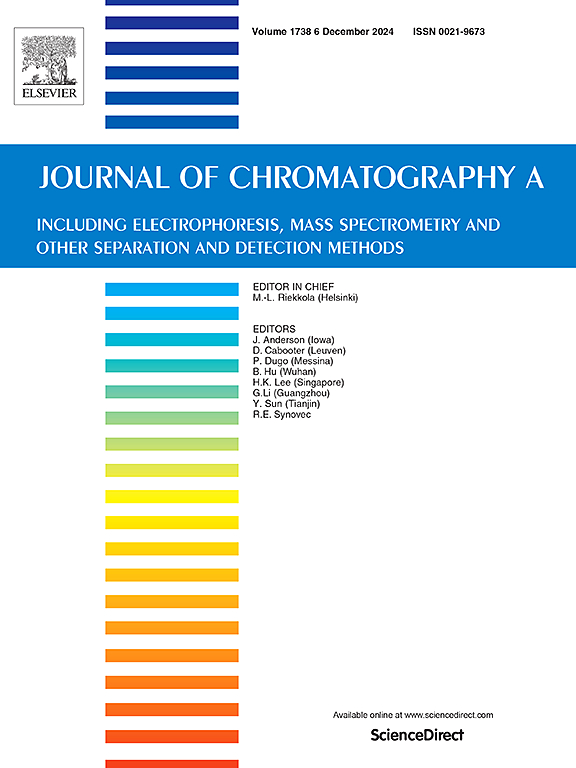可重复使用分层孔PVDF-MIL-101(Cr)泡沫的合成及其对水中氟喹诺酮类阴离子和阳离子染料的吸附行为
IF 4
2区 化学
Q1 BIOCHEMICAL RESEARCH METHODS
引用次数: 0
摘要
本研究采用牺牲模板法,以NaCl为牺牲模板,设计并制备了新型分层孔MIL-101(Cr)泡沫(HPF-MIL-101)。以PVDF为粘合剂,MIL-101(Cr)为吸附剂,通过研磨、加热和洗涤NaCl模板制备HPF-MIL-101。这种制备过程既简单又具有成本效益,避免了任何有机试剂的使用或产生,从而为生产金属-有机框架(MOF)复合材料提供了一种环境可持续的方法。制备的hff - mil -101对阴离子染料(甲基橙,MO)和阳离子染料(亚甲基蓝,MB)均有良好的吸附性能。吸附过程符合拟二级动力学模型和Friedrich等温线模型,为多层吸附。韦伯-莫里斯颗粒内扩散模型进一步支持了这一观点,该模型将吸附过程分为三个阶段。吸附过程符合Freundlich等温模型,相关系数(r)大于0.96。HPF-MIL-101也可用作固相萃取(SPE)的吸附剂。为此,建立了以hff - mil -101为吸附剂的固相萃取-高效液相色谱法(HPLC)分析水样中5种氟喹诺酮类药物的方法。该方法在30 ~ 2000 ng·mL-1范围内具有良好的线性关系(r = 0.9991 ~ 0.9999),合理的提取回收率为80.39 ~ 112.7% (RSD≤7.9%),最低检出限为8 ~ 30 ng·mL-1。综上所述,HPF-MIL-101不仅具有简单、环保、无公害的制备工艺,而且可以重复利用于水中痕量FQs的富集和检测。因此,HPF-MIL-101在环境污染物去除方面具有巨大的应用潜力,也为其他MOF复合材料的制备和应用提供了有价值的参考。本文章由计算机程序翻译,如有差异,请以英文原文为准。
Synthesis of reusable hierarchical Pore PVDF-MIL-101(Cr) foam for Solid phase extraction of fluoroquinolones from water and its adsorption behavior for anionic and cationic dyes
In this study, a novel hierarchical pore MIL-101(Cr) foam (HPF-MIL-101) was designed and prepared using the sacrificial template method with NaCl as the sacrificial template. This method involved grinding, heating, and washing the NaCl template to produce HPF-MIL-101, with PVDF as the binder and MIL-101(Cr) as the adsorbent. This preparation process is both straightforward and cost-effective, avoiding the use or generation of any organic reagents, thereby offering an environmentally sustainable approach for producing metal-organic framework (MOF) composites. The prepared HPF-MIL-101 exhibited excellent adsorption capabilities for both anionic dye (methyl orange, MO) and cationic dye (methylene blue, MB). The adsorption process followed a pseudo-second-order kinetic model and Friedrich isotherm model, indicating a multilayer adsorption. This is further supported by the Weber-Morris intraparticle diffusion model, which divided the adsorption process into three stages. Furthermore, the adsorption process was consistent with the Freundlich isotherm model, with a correlation coefficient (r) greater than 0.96. HPF-MIL-101 can also be used as an adsorbent for solid phase extraction (SPE). Therefore, an SPE method combined with high-performance liquid chromatography (HPLC) was developed using HPF-MIL-101 as the adsorbent to analyze five fluoroquinolones (FQs) in water samples. This analytical method showed good linearity in the range of 30–2000 ng·mL−1, with excellent linear correlation coefficient (r = 0.9991–0.9999), reasonable extraction recoveries ranging from 80.39 to 112.7 % (RSD ≤ 7.9 %), and low limits of detection (8–30 ng·mL−1). Overall, the results indicated that HPF-MIL-101 not only had a simple, environment-friendly, and pollution-free preparation process but also can be reused for enrichment and detection of trace FQs in water. Thus, HPF-MIL-101 exhibits immense application potential in environmental pollutant removal and also provides a valuable reference for the preparation and application of other MOF composites.
求助全文
通过发布文献求助,成功后即可免费获取论文全文。
去求助
来源期刊

Journal of Chromatography A
化学-分析化学
CiteScore
7.90
自引率
14.60%
发文量
742
审稿时长
45 days
期刊介绍:
The Journal of Chromatography A provides a forum for the publication of original research and critical reviews on all aspects of fundamental and applied separation science. The scope of the journal includes chromatography and related techniques, electromigration techniques (e.g. electrophoresis, electrochromatography), hyphenated and other multi-dimensional techniques, sample preparation, and detection methods such as mass spectrometry. Contributions consist mainly of research papers dealing with the theory of separation methods, instrumental developments and analytical and preparative applications of general interest.
 求助内容:
求助内容: 应助结果提醒方式:
应助结果提醒方式:


